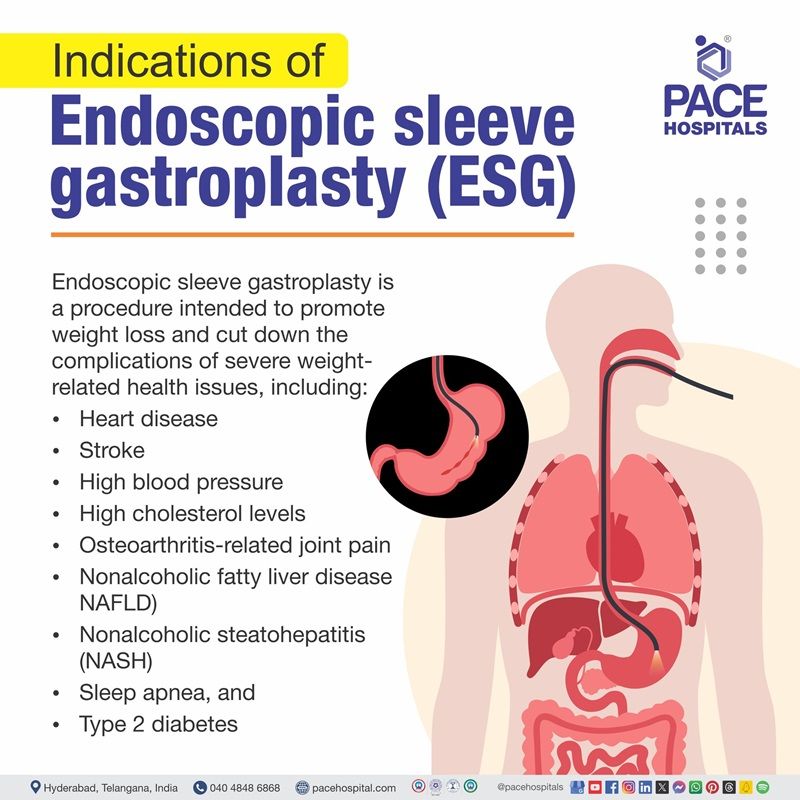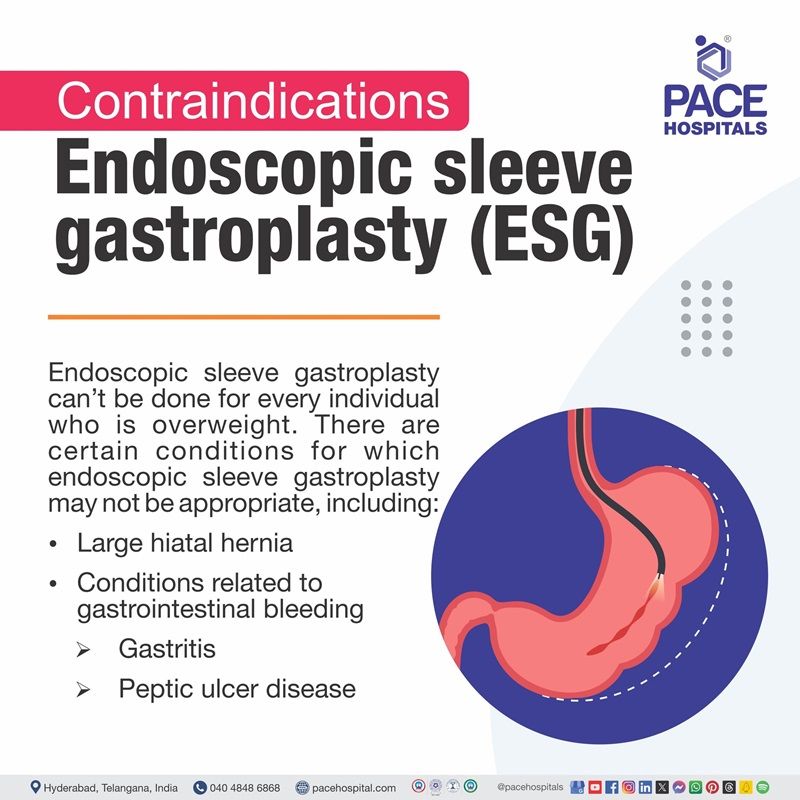Endoscopic Sleeve Gastroplasty in Hyderabad, India | Cost & Benefits
PACE Hospitals stands as the Best Hospital for Endoscopic Sleeve Gastroplasty in Hyderabad, India, offering an advanced minimally invasive, non-surgical approach to weight loss that is both safe and effective. ESG, a minimally invasive procedure, is performed by our highly skilled team of interventional gastroenterologists and bariatric experts who are pioneers in the field of endoscopic weight loss treatments.
At PACE Hospitals, we prioritize patient safety and comfort, employing state-of-the-art technology to ensure precision and minimal recovery time with highest standards of care and safety. Each patient receives a personalized treatment plan tailored to their specific needs, supported by comprehensive nutritional and lifestyle counseling to maximize the long-term success of the procedure. Our commitment to post-procedure care sets us apart, with dedicated follow-up programs designed to provide patients with continuous support on their weight loss journey, ensuring sustainable and healthy outcomes.
Request an appointment for Endoscopic Sleeve Gastroplasty (ESG)
Endoscopic Sleeve Gastroplasty appointment
Why choose us
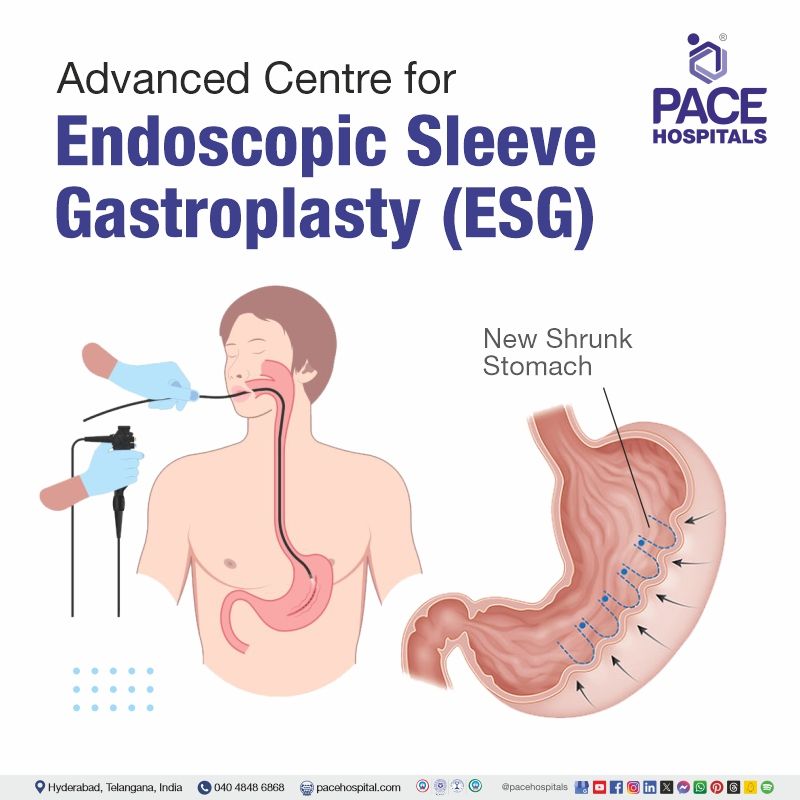
Minimally Invasive, Non-Surgical Weight Loss Procedure
Team of the Best Bariatric Doctors in Hyderabad
Precision Treatment with 99.9% success rate
All insurance accepted with No-cost EMI option
ESG - Endoscopic Sleeve Gastroplasty definition
Endoscopic Sleeve Gastroplasty (ESG) surgery is a minimally invasive endobariatric weight reduction procedure that involves reducing the size of the stomach (about 70%) with the help of an endoscope and an endoscopic suturing device. Interventional
gastroenterologists perform the ESG procedure by inserting an endoscope through the mouth, suturing the front and back walls of the stomach, tightening them, and bringing the walls together. This results in decreasing the stomach volume and its length, leading to a delay in stomach emptying or feeling full for longer.
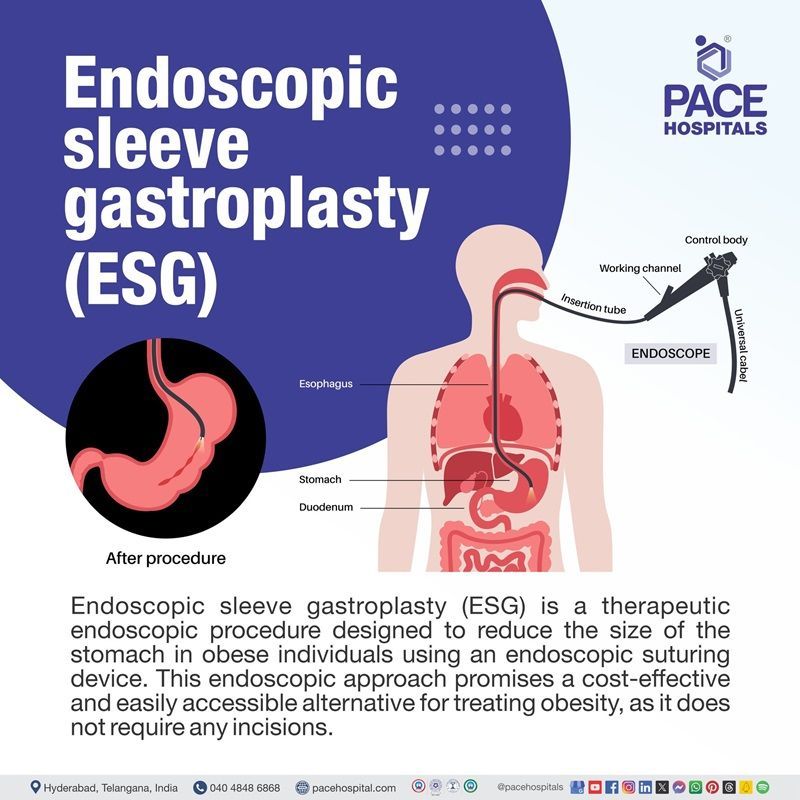
Endoscopic Sleeve Gastroplasty Diet
The diet after ESG surgery plays a vital role in determining the efficacy of it. The patient will be suggested to follow up with dieticians or nutritionists at least twice a month for the first three months, followed by once a month, based on their condition.
The following hierarchy is the endoscopic sleeve gastroplasty diet after surgery, which dieticians or nutritionists might suggest for the initial few weeks from the day of surgery:
- Only clear liquids for the first eight hours post-surgery.
- Powdered protein-associated liquid diet for the first week.
- Low sugar and fat-associated soft foods for the second week.
- Small portions of solid food after four weeks.
Endoscopic Sleeve Gastroplasty results
The ESG weight loss results are purely dependent on the diet and lifestyle changes post-ESG surgery. However, the studies have demonstrated the ESG surgery results have shown significantly greater weight loss (nearly 16% total body weight loss and nearly 60% excess body weight loss) after one year of surgery compared to a combination of high-intensity diet and lifestyle therapy alone (low-calorie diet, behavioral therapy and increase in physical activity).
A 2022 international study showed a significant decrease in excess body weight loss (17.3% at one month, 29.2% at three months, and 35.6%at six months; p<0.000) and body mass index (7.3 kg/m2 at three months, 9.3 kg/m2 at six months and 8.6 kg/m2 at 12 months; p<0.000) in obese patients (average weight of 38.7 kg/m2). In addition to a sustained decrease in body weight and body mass index for 12 months, it had also shown a decrease in mean HbA1c, liver enzymes (alanine transaminase and aspartate aminotransferase), triglycerides, and low-density cholesterol (bad cholesterol).
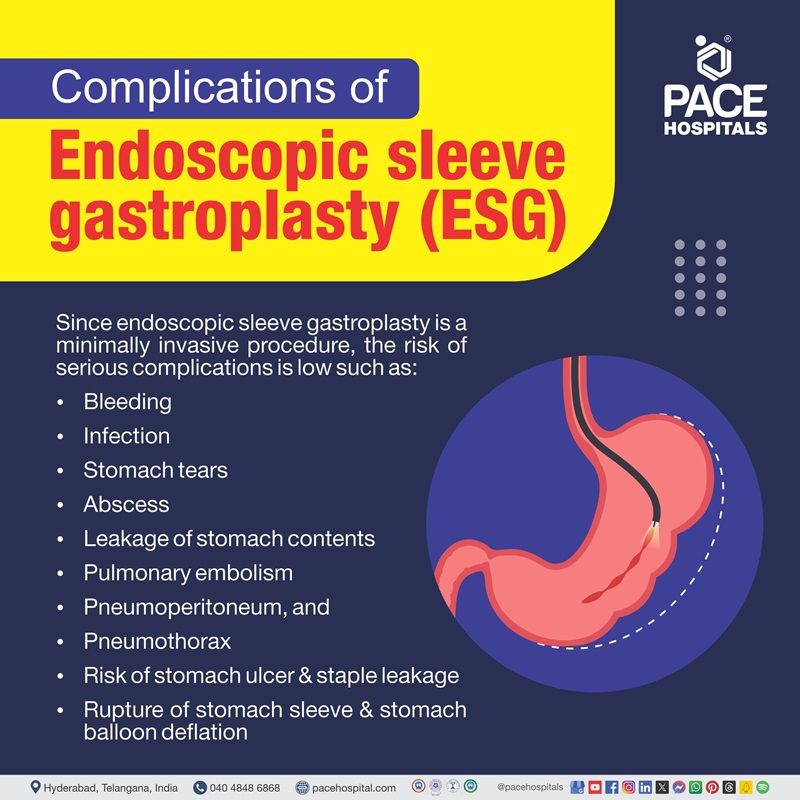
Endoscopic Sleeve Gastroplasty complications
Endoscopic sleeve gastroplasty has proven to be a safe and effective procedure (based on the research studies). However, some patients might show side effects post-surgery, which might resolve on their own within two to three days or might require treatment. The following are the endoscopic sleeve gastroplasty side effects:
- Stomach pain
- Vomiting
- Abdominal bloating
- Dehydration
- In some research studies, apart from the above, the following are the serious adverse effects of ESG.
- Gastrointestinal bleeding
- Perigastric fluid leak
- Pulmonary embolism (blood clot that stops blood flow to lungs)
- Pneumoperitoneum (presence of air in the abdominal cavity)
- Deep vein thrombosis (formation of blood clots in deep veins)
Endoscopic Sleeve Gastroplasty in Pregnancy
Obesity is the major common health problem in women of reproductive age (20 to 39 years), where nearly 40% of women are being affected. Obesity at the initial stages of pregnancy can be a potential risk factor for gestational and postpartum maternal complications, in addition to adversely affecting fetal, neonatal, and infant outcomes.
Endoscopic sleeve gastroplasty procedure is an effective option for weight loss, especially in women of childbearing age. The gastroenterologist might advise avoiding pregnancy for at least 1.5 years following an ESG procedure. As per the research studies, patients who underwent Endoscopic sleeve gastroplasty prior to pregnancy had shown lower rates of several adverse obstetric outcomes such as gestational diabetes mellitus, gestational hypertension, postpartum hemorrhage, and cesarean delivery in comparison to controls who were matched for pre-surgery BMI.

Advantages of Endoscopic Sleeve Gastroplasty (ESG)
- There will be no formation of post-surgical scars, as it is an endoscopic procedure where an endoscope will be inserted through the mouth.
- Required fewer hospitalization days compared to other bariatric procedures.
- Aids in low food intake due to low gastric volume, thereby reducing body weight.
- Cost-effective therapy compared to other bariatric procedures.
- No alterations in the natural flow of digestion.
Questions that the patients can ask the healthcare team post Endoscopic Sleeve Gastroplasty (ESG)?
- What are the possible side effects I can have after the procedure?
- Is my endoscopic sleeve gastroplasty procedure successful?
- To whom should I consult if I have any complications?
- What diet precautions should I follow?
- When should I come back for further follow-up?
Difference between endoscopic sleeve gastroplasty vs sleeve gastrectomy
Endoscopic sleeve gastroplasty vs gastric sleeve
Both procedures are used to reduce the volume or size of the stomach; however, the following are the differences between them:
| Elements | Endoscopic sleeve gastroplasty (ESG) | Sleeve gastrectomy (SG) |
|---|---|---|
| Effectiveness | According to research reports, ESG was slightly less effective than sleeve gastrectomy. | As per research reports, sleeve gastrectomy has been more effective than ESG. |
| Type | Endoscopic technique | Surgical procedure |
| Incisions / Scars | No incisions will be made as this procedure is done by inserting an endoscope. | Small incisions will be made on the abdominal wall through a laparoscopic procedure. |
| Safety | ESG is a safe procedure with minimal complications compared to sleeve gastrectomy | The risk of complications in sleeve gastrectomy is high compared to ESG, as sleeve gastrectomy surgery involves the cutting and stapling of the stomach. |
| Recovery | 2-3 days; might extend based on patient’s condition | 2-3 weeks; might extend based on patient's condition |
Frequently Asked Questions (FAQs) on Endoscopic Sleeve Gastroplasty (ESG)
How long does endoscopic sleeve gastroplasty last?
The effect of endoscopic sleeve gastroplasty depends on the patient's condition and their determination to have a healthy lifestyle. However, as per the research studies, the durability of endoscopic sleeve gastroplasty lasts for one to five years.
Is ESG better than gastric sleeve?
It is based on the patient’s condition and requirement, as both procedures are used to decrease the volume or size of the stomach. However, the surgical gastroenterologist might opt for ESG over gastric sleeve as it is an endoscopic procedure that is done with the help of an endoscope that doesn't require any skin cutting followed by low post-surgical complications compared to gastric sleeve.
Is ESG surgery permanent?
Yes, ESG procedure is a permanent procedure as it is a non-invasive, endoscopic procedure used to decrease body weight by reducing the stomach size (up to 70%) with the help of sutures, resulting in the formation of a sleeve-shaped stomach. Thus, it reduces the size and volume of the stomach, leading to an increase in the feeling of fullness or delay in stomach emptying. These non-absorbable sutures are strong enough to hold the shape of the stomach (sleeve or tube shape), which aids in the provision of long-lasting duration.
Is endoscopic sleeve gastroplasty a safe procedure?
Endoscopic sleeve gastroplasty (ESG) is a safe weight loss procedure due to its minimal invasive nature and low risk of serious complications. Side effects like pain, nausea, and vomiting are temporary and can be treated with medication. This procedure is also effective and can produce clinically significant results, with a lower risk of adverse events compared to surgical interventions and intragastric balloon procedures
What are the risks of ESG procedure?
The risk of ESG surgery varies with the person; however, post-ESG surgery, the patient might feel sharp stomach pain, nausea, and vomiting that might last for a few days from the day of the surgery. The gastroenterologist might prescribe medications to subside the side effects of ESG surgery.
How long does it take the stomach to heal after ESG?
ESG is a non-invasive and endoscopic procedure where an endoscope will be inserted through the oral route (mouth). Depending on the patient's condition, the patient might get discharged within a couple of days. The patient can resume their work or daily activities within one to three days after the procedure. The patient can be expected to fully recover after four weeks from the day of the procedure.
When can you work out after ESG?
The patient can have workout exercises after two weeks from the day of ESG surgery. During the first week, the patient will be advised not to lift heavy objects and can perform moderate exercises. The patients will be encouraged to move out of bed or perform light exercises such as climbing steps and taking care of themselves. After one month, the patient might shift to regular exercises as they initiate taking solid foods after four weeks of ESG procedure.
How often should I follow up with a nutritionist after ESG?
For the patient who underwent an endoscopic sleeve gastroplasty procedure, the gastroenterologist strongly recommends having a follow-up with a dietician or nutritionist at least twice a month, as diet plays a major role in the success of an endoscopic sleeve gastroplasty procedure.
Will endoscopic sleeve gastroplasty affect the daily medications?
No, the endoscopic sleeve gastroplasty procedure doesn’t affect the effectiveness of the daily medications. However, the patient can experience a longer onset time if they have consumed in a tablet or capsule form. Some anti-inflammatory agents might cause stomach irritations more than before the procedure.
How much weight can I expect to lose with ESG?
Reduction of body weight after an ESG surgery is completely based on the patient's commitment to the diet and lifestyle changes. Adhering to strict diet and adopting healthy lifestyle as per the dietician's plan or gastroenterologist's advice post-ESG can aid in reducing up to 59% of excess weight in a duration of one year.
How does ESG differ from other weight loss surgeries?
The working principle of endoscopic sleeve gastroplasty includes stitching of the front and back walls of the stomach, resulting in a decrease in stomach size with the help of an endoscope that is passed through the mouth, whereas other weight loss surgeries such as sleeve gastrectomy, which includes removal of part of the stomach thereby reducing its size and shape. The sleeve gastrectomy can be performed through minimally invasive procedures such as laparoscopic, where the gastroenterologist place 2 to 3 tiny incision on the patient's abdomen and insert the laparoscope and other surgical tools to cleave the stomach.
What is the success rate of endoscopic sleeve gastroplasty?
The success rate of Endoscopic Sleeve Gastroplasty (ESG) can vary based on factors such as patient selection, lifestyle changes, and individual metabolic responses. Studies typically report an average percentage of total body weight lost (TBWL) ranging from 15% to 20% at one year post-procedure. Patients can maintain a significant portion of weight loss over a two- to five-year period, although some may regain weight. Factors influencing success include patient motivation, comorbidities, and follow-up care from healthcare professionals. While ESG has shown promising results in weight loss and metabolic health improvements, individual success can vary widely.
What is the cost of endoscopic sleeve gastroplasty in Hyderabad, India?
Endoscopic Sleeve Gastroplasty cost in Hyderabad can vary from ₹3,75,000 to ₹5,25,000 (US$4460 - US$6250), depending on several factors, including the hospital equipment and facilities, location of the hospital, the qualifications and experience of the doctor, hospital stay & associated costs, pre-procedure evaluations, diagnostic tests, medications & supplements, the type of anesthesia used (local, regional, or general), any additional procedures, insurance coverage, pre- and post-surgery care.
It is important for a person considering Endoscopic Sleeve Gastroplasty (ESG) should consult with a interventional gastroenterologist to obtain personalized cost. This ensures a clear understanding of the potential charges, procedure details, and associated risks before proceeding with the procedure.

